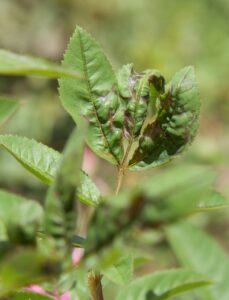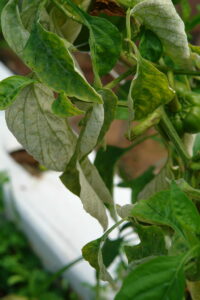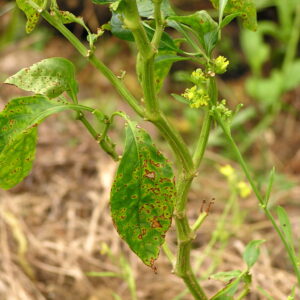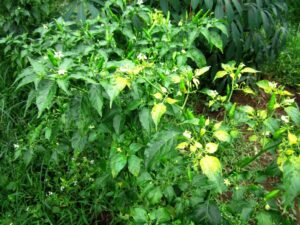Chilli
Chilli is known as the most valuable crop of India. It is used as a principle ingredient of various curries and chutneys, also used in vegetable, spices, condiments, sauces and pickles. Pungency is chillies due to the active constituent “Capsaicin”, an alkaloid. The native home of chilli is considered to be Mexico.
Important Points-
- Chilli is day neutral plant.
- Maximum area, production and consumption of chilli in the world is India.
- India’s share in total export of chilli in the world is 4%
- Dry chilli generally contain about 6% stalk, 40% pericarp, 54% seeds.
- Green to dry chilli ratio is 10:1
- Varieties with thin pericarp, less seed, strong spike is suitable for drying or powder making.
- In India, leading supplier of Off season chilli is Himachal Pradesh
- Chilli is richest source of Vitamin C.
- Chilli is Self-Pollinated plant
- It has determinant type of growth
- Yellow color in Chilli is due to the pigment “Leutine” whereas Green color is due to the presence of “Chlorophyll”
IMPORTANCE OF CHILLI:
Following are the health benefits and importance of chillies-
| Calories | 6% |
| Water | 88% |
| Protein | 0.3gm |
| Carbohydrates | 1.3gm |
| Sugar | 0.8gm |
| Fiber | 0.2gm |
| Fat | 0.1gm |
- Chilli Peppers are rich source of vitamins and minerals but usually eaten in small amounts- so they don’t contribute to your daily micronutrient intake.
- Chilli Peppers are rich in antioxidant plant compounds that have been linked to various health benefits. Most notable is Capsaicin, which is responsible for the pungent (Hot) taste of chilli Peppers.
- Chilli are associated with several health benefits. They may promote weight loss when combined with other healthy lifestyle strategies and may help relieve pain caused by acid reflux.
- Boost immune system, helping fight flu, cold and fungal infections
- Reduce risk of Type 2 Diabetes.
- Improves eye health
- Promotes red blood cell growth
- Reduce cancer risk
- Reduce joint pain
- Helps in migraine
Chillies are produced throughout the year. Two crops are produced Kharif and Rabi season in the country. Sowing of Chilli for the Kharif crop season takes place between July-August while for the Rabi season, Chilli is sown over October-November.
Andhra Pradesh, Karnataka, Maharashtra, Bihar, Madhya Pradesh, Chhattisgarh are the major chilli growing states in India.
- Chilli performs well in warm humid tropical and subtropical regions.
- Optimum temperature range of 20-25oC is required for chilli cultivation.
- Temperature beyond 40oC result in poor fruit set as well as severe fruit drop.
Chilli can be grown in wide range of soils but well drained, sandy loam soil rich in organic matter is best suited for chilli cultivars. The light soils produce better quality fruits than heavy soils. Soil pH should be 5.5-6.5
For varieties use seed rate of 200gm/acre and 80-100gm/acre for hybrids.
Seed Treatment:
To protect crop from various soil borne disease seed treatment is necessary. Before sowing do seed treatment with Thiram @3gm or Carbendazim @2gm/kg of seeds. After chemical treatment, treat seed with Trichoderma @5gm/kg of seed or Pseudomonas fluorescens @10gm/kg. Keep it in shade and use it for sowing. Do watering with rosecan on daily basis. Drench the nursery with Copper Oxychloride @2.5gm/L of water at 15 days interval to prevent crop from damping off disease.
To protect against wilt, sucking pest, dip roots for 15 min in Trichoderma harzianum @20gm/L + 0.5ml/L Imidacloprid before transplanting.
Spacing:
Use Row to Row spacing of 75 cm and plant to plant spacing is 45 cm
Thoroughly prepare the field with the addition of FYM @25 t/ha and form ridges and furrows at a spacing of 60 cm. Apply 2kg/ha of Azospirillum and 2kg/ha of Phoshphobacteria by mixing with 20kg of FYM. Irrigate the furrows and transplant 40-45 days old seedlings, with the ball of earth on the ridges.
Nursery Practices-
- Approximately 250m2 area will be sufficient for raising the seedlings to plant one hectare.
- Generally nursery beds are prepared in the size of 7.5m long, 1-1.2m width and 10-15 cm height.
- Well decomposed farmyard manure is properly mixed in to top soil of the bed at the rate of 3kg/m2.
- For raising healthy seedlings, seeds should be treated before sowing with captan or Thiram @2g/kg of seeds is essential.
- The seeds are sown in a bed are covered with a thin layer of dry grass or compost, thereafter the beds are irrigated with a rosecan.
- The seedlings will be ready for transplanting after 4 to 6 weeks of seed sowing.
In India, the major areas under chillies are mostly rainfed, Generally, in India 8 to 9 irrigation are given depending on rainfall, soil type, and humidity and prevailing temperature.
- Chilli respond well to application of fertilizers both under irrigation and rainfed conditions.
- Generally, in chilli 250-500 quintal /ha FYM, 350kg/ha Ammonium nitrate, 175 kg/ha SSP and 100 kg/ha Potassium Sulphate are applied to get good yield.
- Full dose of P and K and a half dose of N are to be applied at the time of transplanting and remaining dose of nitrogen give 35-40 days after transplanting.
Fertilizer requirement (kg/acre)
| Fertilizer | Dosage |
| Urea | 55 |
| SSP | 75 |
| Muriate of Potash | 20 |
- Apply Nitrogen @25kg in form of Urea @55kg.acre, Phosphorus @12kg in the form of Single Super Phosphate @75 kg and Potash @12kg in form of MOP @20 kg/acre.
- To obtain high yield take spray of MAP 12:61:00 @75gm/15 L of water at 40-45 days after transplanting at branch growing stage.
- To increase yield along with to obtain more no of pickings, apply Sulphur/Bensulf @10 kg/acre and spray calcium Nitrate @10gm/L of water in flowering stage.
Water Soluble Fertilizer-
10-15 days after transplantation, spray 19:19:19 with micronutrients @2 gm/L of water. Then after 40-45 days spray 20% Boron @1gm+micronutrient @2gm/L of water should be done. When crop is in flowering stage spray 0:52:34 @4-5+micronutrient @2.5-3gm/L of water. When crop is in fruit formation stage spray 13:0:45 @4-5gm+calcium nitrate @3 gm/L of water.
Growth Regulators-
To control flower drop and to get good quality fruit, take spray of NAA (Naphthalene acetic acid) @4ml/15 L of water at flower initiation stage. To increase fruit set having good quality, spray Triacontanol growth regulator at 1.25ml/L of water on 20, 40, 60 and 80th day of planting.
- Weed intensity is generally more in red soils than in black soils in the same locality.
- 2-3 shallow hoeing should be given to the soil to kill the weeds. Weedicides like Lasso @1.5L/ha are also effective. The herbicide Dephenamide , trifluralin , EPTC, had given good results in chilli crop.
- Various mulches such as saw dust, gravels, crop residues, plastic films etc. are used to control weed population.
- Apply Pendimethalin @1L /acre or Fluchloralin @800 ml/acre as pre-emergence herbicide followed by hand weeding once 30 days after planting.
- Nitrogen Deficiency-
Symptoms-
- Yellowing of older leaves
- Stunted growth, poor fruit setting
Management- Spray 2% urea
- Phosphorus Deficiency-
Symptoms-
- Reddish purplish color of older leaves.
- Poor root growth.
Management- Soil application of recommended dose of phosphorus should be applied at the time of sowing or planting.
- Potassium Deficiency –
Symptoms –
- Older leaves turn into thick green
- Burning of leaf margins
- Yield loss
- Fruit development is less
Management- Foliar application of K2SO4 @1%
- Calcium Deficiency –
Symptoms-
- Symptoms first seen on growing tip of plant, the leaves curl upward.
- Flower buds are failed to develop, youngest leaves will remain small and deformed.
Management- Foliar application of 2% calcium sulphate twice at weekly intervals.
- Magnesium Deficiency-
Symptoms-
- Interveinal Chlorosis
- Appear on the older leaves, poor seed formation
Management – Foliar spray of MgSO4 @2%
- Sulphur Deficiency-
Symptoms-
- New leaves become pale yellow in color.
- Reduces the pungency and keeping quality.
- Dark brown sharp, sharply delimited spots appear mainly in the marginal area.
Management-
Foliar spray of K2SO4 or CaSO4 1% twice at fortnightly interval.
- Copper Deficiency-
Symptoms- Yellowing of veins in younger leaves.
Management- Foliar spray of 0.5% CuSO4 twice at fortnightly interval.
- Boron Deficiency –
Symptoms-
- Curling of leaves, irregular formation of leaves.
- Flower and fruit dropping, irregular formation of fruit.
Management- Foliar spray of Borax @0.2%
- Iron Deficiency-
Symptoms –
- Leaf become pale white in color.
- Keeping quality is reduced
- Yield is reduced
Management- Foliar spray of FeSO4 @0.5%
- Manganese Deficiency-
Symptoms- Yellowing of younger leaves and veins remain green in color, if the deficiency is more in leaves it turns to brown color.
Management- Foliar spray of MnSO4 @2%
Physiological Disorder is the abnormal growth pattern or abnormal external or internal conditions of fruits due to adverse environmental conditions.
- Blossom End Rot-
Caused by- Blossom End Rot is caused due to calcium deficiency.
Symptoms- Blossom End Rot symptoms begin as a light green or yellow-colored sunken spot and expand to a larger collapsed area that begins to turn black. BER affected fruits tend to turn color prematurely from green to brown and then red.
Management-
- Use of disease free seeds
- Avoid stagnation of water and good drainage to be maintained.
- Avoid using excessive amount of ammonia forms of nitrogen which reduce calcium uptake. Instead used nitrate form of nitrogen.
- Seed treatment with Thiram or Captan @4gm/kg of seeds.
- Foliar application of Ca based fertilizers.
2. Sunscald-
Caused by- Sunscald is caused when fruit is exposed to excessive sunlight or high temperature.
Symptoms-
The side of the fruit facing sun turns whitish, blistered and papery. Sunscald on pepper leaves will start with leaves turning brown or ivory white, quickly becoming dry and crispy to touch.
Management-
- Grow resistant varieties
- Prune the affected plant parts to prevent the spread of disease.
- Increase foliage density
- Do not water at full sunlight, rather irrigate in the evening than morning or afternoon.
3. Fruit or Skin cracking-
Caused by – Fruit cracking is caused due to the deficiency of Boron and Copper.
Symptoms-
- The cracks usually begin to appear as the pods turn from green and black to red.
- Fine superficial cracks on the fruit’s surface gives a rough texture to the fruit.
Management-
- Proper irrigation and nutrient management can reduce help cracking.
- Avoid high relative humidity
- Plant resistant cultivars
4. Fruit or Flower drop-
Caused by- Fruit or flower drop can be caused due to various factors such as –
- Environmental factors- One of the most common causes of flower drop in chilli plant is environmental stress. This can include factor such as extreme temperature, high humidity, low light levels or irregular watering.
- Inadequate pollination- Pollination is a critical step in the fruiting process, and if it may doesn’t happen, flowers may drop off the plant.
- Nutrient Deficiencies- Chilli plants require specific nutrients to grow and produce fruits. A deficiency in any of these nutrients, such as nitrogen, potassium can cause flower drop.
- Pest and Diseases- Insect pest like aphids or diseases like powdery mildew can cause flower drop in chilli plants. These pest and disease can cause stress to the plant, leading to flower drop as a survival mechanism.
Symptoms-
- Flowers and young fruits may wilt and drop off the plant suddenly without apparent reason.
- Flowers or young fruits may exhibit signs of yellowing or browning before dropping off.
- Plants may show signs of stunted growth, with flowers or fruits failing to develop fully before dropping
- The plants may produce fewer flowers overall, and those that do appear may drop off before setting.
Management-
- Spraying of NAA with 2-3 ml/10 L of water at 45 and 60 days after transplanting induce early flowering and prevents flower and fruit drop.
- Maintain proper irrigation. It is essential to keep the soil moist and drip irrigation system can help in providing consistent water supply to the plant.
- Maintain proper pruning
- Fruit Borer-
Symptoms of damage-
- Caterpillar eat leaves of crop afterward they enter into fruit and caused heavy loss in yield.
- Small holes on the surface of the leaves
- Infested fruits often wilt and develop discolored patches around the entry holes.
- In severe cases fruits may drop prematurely from the plant.
Management-
- Collect and destroy damaged fruits and grown up caterpillars
- Set up pheromone trap @5/acre
- Spray Chlorpyrifos + Cypermethrin @30ml/12 L of water with power sprayer.
- Yellow Mite-
Symptoms of damage-
- Nymphs and adults feed exclusively on the lower surface of the leaves.
- Infected leaves give cup shape appearance.
- Heavy infestation results in defoliation, bud shedding and drying of leaves.
- Curling and crinkling of leaves followed by blister patches.
- Stunted growth and plants may die off in severe cases
Management-
- Spray Chlorfenapyr @1.5ml/L of water or Abamectin @1.5ml/L of water are found effective.
- Aphids-
Symptoms of damage-
They attack mostly in winter month and later stage of crop. They suck sap from the leaf. They excrete honey like substance and developed sooty mold i.e., blackish color fungus on the calyx and pods thus deteriorate quality of product. Aphids also work as important insect vectors for chilli mosaic. Mosaic disease transmitted by aphids cause 20-30% loss in yield.
Management-
- Spray Acephate 75 SP @5gm/L of water or Methyl demeton 25EC @2ml/L of water
- Soil application of Carbofuran, Phorate @4-8kg/acre on 15 and 60 days after transplanting are also effective.
- Treat seeds with Imidacloprid 70% WS @12g/kg of seed.
- Tobacco cutworm-
Symptoms of damage-
- Newly hatched larvae scrap the green matter in the leaf.
- Affected leaf looks like a papery white structure.
- In severe infestations they feed on the entire lamina and petiole.
Management-
- Plough the soil to expose and kill pupae.
- Castor as a trap crop
- Set up pheromone trap @15/ha
- Collect and destroy the egg masses, larvae and grown up caterpillars.
- Spray any one of the following insecticides-
Emamectin benzoate 5% SG 4gm/10 L of water
Flubendiamide 20 WDG @6gm/10 L of water
Thiodicarb 75% WP @2gm/L of water
- Thrips-
Symptoms of damage-
- The infested leaves develop crinkles and curl upwards.
- Elongated petiole
- Buds become brittle and drop down
- Infestation leads to stunted growth

Management-
- Grow Agathi as intercrop
- Do not grow chilli after sorghum
- Treat seeds with Imidacloprid 70%WS @12gm/kg of seeds.
- Spray any one of the following insecticide-
Imidacloprid 17.8%SL @3ml/10L of water
Dimethoate 30%SC @1ml/L of water
Emamectin benzoate 5%SG @4gm/10 L of water
Fipronil 5%SC @1.5ml/L of water
- Whitefly-
Symptoms of damage-
- Chlorotic spots
- Yellowing
- Downward curling and drying of leaves
Management-
- Install yellow sticky traps @12/ha to attract the adult.
- Remove alternate weed host
- Uproot and destroy affected leaf curl plants
- Use nitrogen and irrigation judiciously
- Apply any one of the following insecticide-
Carbofuran 3% G @5gm/L of water
Dimethoate 30% EC @1ml/L of water
Malathion 50%EC @1.5ml/L of water
Imidacloprid 17.8SL @3ml/10 L of water
- Root Knot Nematode-
Symptoms of damage-
- Presence of gall on the roots
- Plants wilt rapidly especially under dry growing conditions and are often stunted.
- Growth may be retarded and leave may be chlorotic
- In cases where seedlings infestation taken place, numerous plants die in the seed bed and seedlings do not survive transplanting.
- Flowering and production reduced
Management-
- Only seedlings with roots free of galls should be selected for transplanting
- Application of Pseudomonas fluorescens 10gm/m2 in nursery.
- Crop rotation with non-host and resistant plants
- Proper weed control
- Destruction of galled roots after harvest
- Application of Carbofuran 3G @1kg/ha
- Damping Off-
Causal Organism- Pythium aphanidermatum
Symptoms-
- Seedlings killed before emergence
- Water soaking and shriveling of stem.
- Impact of disease symptoms shown at after sowing of seeds in seed beds.
- It will reduce the seed germination percentage.
- It affects the young seedlings and their stems.
Favorable Conditions- Moist soil, Poor drainage, 90-100% R.H. and soil temperature of 20oC.
Management-
- Soil drenching with copper oxychloride 0.25%
- Avoid shade places for nursery establishment
- Use recommended seed rate
- Avoid flooding type of irrigation and maintain optimum moisture level in nursery.
- Use Thiram or Captan @4gm/kg of seeds
- Fruit Rot or Die Back-
Causal Organism- Colletotrichum capsici
Symptoms-
- Infection usually begins when the crop is in flower stage, flowers drop and dry up.
- As the fungus causes necrosis of tender twigs from the tip backwards the disease is called die-back.
- There is shedding of flowers. The flower stalk shrivel and dry up.
- Partially affected plants bear fruits which are few and of low quality.
- On the surface of the soil necrotic areas are found separated from the healthy area by a dark brown to black band.
Management-
- Use disease free seeds
- Seed treatment with Thiram or Captan $4gm/kg of seeds
- Spray Ziram 0.25%, Captan 0.2% or Wettable sulphur 0.2% , Copper oxychloride 0.25% reduced the disease incidence.
- Powdery Mildew-
Causal Organism- Leveillula taurica
Symptoms-
- Shedding of foliage
- White powdery growth on lower side of leaves

Management- Spray wettable sulfur 0.25%
- Bacterial Leaf Spot-
Causal Organism- Xanthomonas campestris
Symptoms-
- The leaves exhibit small circular or irregular, dark brown or black greasy spots. As the spots enlarge in size, the center becomes lighter surrounded by a dark band of tissue.
- The spot coalesce to form irregular lesions
- Severely affected leaves become chlorotic and fall off.
- Stem infection leads to formation of cankerous growth and wilting of branches.
- On the fruits round, raised water soaked spots with a pale yellow border and produced.

Management-
- Seed treatment with 0.1% mercuric chloride solution for 2-5 minutes is effective.
- Spray Bordeaux mixture 1% or copper oxychloride 0.25%
- Field sanitation is important. Collect and destroy affected plant debris from the field.
- Cercospora Leaf Spot-
Causal Organism- Cercospora capsici
Symptoms-
- Leaf lesions typically are brown and circular with small to large light grey center and dark brown margins. The lesions may enlarge to 1cm or more in diameter and sometimes coalesce.
- Stem, Petiole and pod lesions also have light grey center with dark borders, but they are typically elliptical.
- Severely infected leaves drop off prematurely resulting in reduced yield.
Management- Spray twice at 10-15 days interval with Mancozeb 0.25% or Chlorothalonil 0.1%
- Fusarium Wilt-
Causal Organism- Fusarium oxysporum
Symptoms-
- Fusarium wilt is characterized by wilting of the plant and upward and inward rolling of the leaves.
- The leaves turn yellow and die.
- Generally, appear localized areas of the field where a high percentage of the plants wilt and die.
- Disease symptoms are characterized by an initial slight yellowing of the foliage and wilting of the upper leaves that progress in a few days into a permanent wilt with the leaves still attached.
- The vascular system of the plant is discolored, particularly in the lower stem and roots.
Management-
- Use of wilt resistant varieties
- Drenching with 1% Bordeaux mixture or Blue copper 0.25%
- Seed treatment with 4g Trichoderma viride or Carbendazim 2gm/kg of seeds
- Leaf Curl-
Causal Organism – Begovirus, it’s a viral disease.
Symptoms-
- Leaves curl towards midrib and become deformed.
- Stunted growth due to shortened internodes and leaves greatly in size.
- Flower buds abcise before attaining full size and anthers do not contain pollen grains.
- The virus is generally transmitted by whitefly

Management-
- The infected plants should be uprooted and burnt or buried to avoid further infection.
- Avoid monoculture of chilli crop.
- Selection of healthy and disease free seeds.
- Suitable insecticidal sprays reduce the incidence of viral diseases, since majority of viral disease are transmitted by insect and pest.
- Apply Carbofuran 3G@4-5kg/acre
- Alternaria Leaf Spot-
Causal Organism- Alternaria solani
Symptoms-
- Cracks appearing in leaf spot
- Leaf spots with concentric rings
- Spots are irregular, 4-8 mm in diameter and may coalesce to cover large areas of the leaf blade.
- Severely affected leaves may drop off
- The infected fruits turns yellow and drop off
Management-
- Spray mancozeb @2gm/L of water
- Spraying 1% Bordeaux mixture or 2gm Copper oxychloride or 2.5 g zineb per litre of water effectively controls leaf spots\
Harvesting can be done 75 days after transplanting. First two pickings yield green chilli and subsequently yield red ripe fruits. Pickings of fruits continues for about 2 months and 6 pickings are taken annually. While harvesting fruits, care should be taken to hold stalk firmly and fruits should be pulled upward gently, breaking the base of the stalk.
YIELD:
Fresh chilli yields vary from 30-40qntl/acre, while dry chilli yields range from 7.5-10qntl/acre